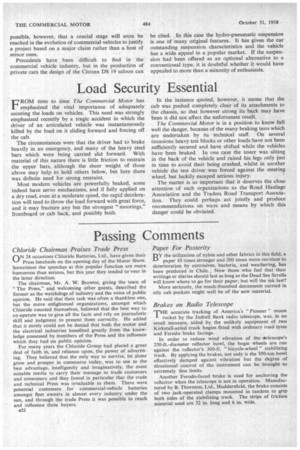Design Frustration
Page 25

Page 26

If you've noticed an error in this article please click here to report it so we can fix it.
The Tribulations of Makers who Produce Revolutionary Power Units or Components
T0 long-distance operators throughout this country and in many other parts of the world the reliability and long life of British-made oil engines constitute a basic economic factor of , the greatest importance. The risk of using a power unit of doubtful wearing properties would, in fact, amount to hazarding their livelihood. However thorough the bench test of a prototype engine and the road tests of the experimental vehicle to which it is fitted may be. operators are hesitant to approve features ofa type entirely different from those of established units.
Many users of heavy vehicles have come to regard a mileage of 200,000 between major overhauls as normal, and any misgivings regarding the ability of a new engine „to provide this would be a deterrent to the purchase of the vehicle.
The one serious aspect of the unassailable reputation created by British makers, particularly when considered in conjunction with the high cost of re-tooling for the production of a new unit, is that the introduction of essentially original features may represent too great a gamble in a highly competitive market. Marketing a revolutionary design can risk the livelihood of the manufacturer as well as that of the purchaser.
Where Boldness May Succeed Unusual design principles applied to other major components of a vehicle are, to a lesser extent, restricted by the same consideration. Past achievements in perfecting established types of component tend_ to limit detail progress. To base production on the principle that faulty detail represents a weak link in the design chain is fundamentally sound and one which British makers Ifft.ve followed with realism. Boldness in the production of a revolutionary design could, however, lead to revolutionary sales in world markets.
Practically every leading maker in the country has emphasized that the minds of operators must be conditioned to the acceptance of the novel. In the case of air suspension, for example, the chief designerof one of our leading companies has stated that the adoption of a wholly pneumatic system for a standard vehicle would prejudice sales, even if test results had shown that it had a longer life between replacements, in addition to affording operational advantages. In his opinion pneumatic
•
springs must, in the first place, be employed in conjunction with leaf springs as a half measure if they are to be accepted by operators generally. In the case of transmissions, also, the makers have generally found that they must cater for the conservatism of operators. If an automatic or semi-automatic gearbox is proposed as a feature of a vehicle, the unit is normally offered as an alternative to the conventional type.
Establishing the worth of an auxiliary as an optional fitting before it is incorporated in the design as a standard feature is a justifiable precaution, but precaution can be carried too far. If the Maker is satisfied that employing a new unit will be of immediate benefit to the user operationally, and of ultimate benefit economically, he may be well advised to instal it as a standard comgonent.
. Standard Models Often Preferred It is a common trait of human nature that whilst a minor claim may be suspect, a major claim is often accepted with confidence. If, for example, a maker offered a power unit which could be fitted with an auxiliary device as an operational extra to increase its output, the majority of buyers would favour the standard unit, despite the immediate benefits which the device would give. The same reasoning can be applied to any major mechanical component; the operator is afraid that he will have to pay too high a price, in terms of maintenance costs or reduced reliability, for an advantage that he would welcome.
A project to which a major claim -would be applicable could be represented by the case of a manufacturer who produced a standard vehicle with original types of engine, transmission, Suspension and chassis structure. It is probable that this bold venture would give operators confidence, whereas half measures would have been criticized. The reward for such an adventurous project could react to the great benefit not only of the manufacturer but also of the commercial vehicle industry and the reputation of the country.
It is debatable whether the more revolutionary projects now in the experimental or prototype stage are sufficiently well advanced to justify the development of a standard vehicle for production in quantity. It is possible, however, that a crucial stage will soon be reached in the evolution of commercial vehicles to justify a project based on a major claim rather than a host of minor ones.
Precedents have been difficult to find in the commercial vehicle industry, but in the production of private cars the design of the Citroen DS 19 saloon can be cited. In this case the hydro-pneumatic suspension is one Of many original features. It has given the car outstanding suspension characteristics and the vehicle has a wide appeal in a popular market. If the suspension had been offered as an optional alternative to a conventional type, it is doubtful whether it would have appealed to more than a minority of enthusiasts.
































































































